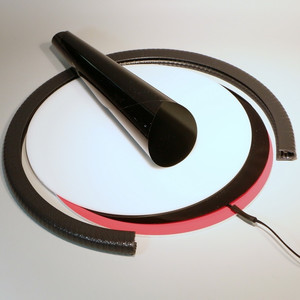Każdy, kto zajmuje się astrofotografią, prędzej czy później natrafia na pojęcie „Flatfield”. Podczas wykonywania zdjęcia przez teleskop pojawiają się błędy obrazu wynikające z różnego natężenia oświetlenia czujnika. Aby oprogramowanie do obróbki obrazu mogło skorygować ten błąd, potrzebne są zdjęcia równomiernie oświetlonej powierzchni, wykonane w takich samych warunkach jak rzeczywiste zdjęcia. Taką powierzchnię tworzy folia świetlna Aurora Flatfield.
Zalety folii świetlnej Aurora Flatfield:
- Całkowicie równomierne oświetlenie otworu obiektywu
- Pełne spektrum, dzięki czemu można je stosować również w połączeniu z filtrami liniowymi
- Dostępne zasilanie 12 V lub napięcie sieciowe
Folie Aurora Flatfield są dostarczane w gotowym montażu w plastikowej ramce: Rama wykonana jest z nietłukącego się tworzywa sztucznego, ma zaokrąglone rogi i jest wyposażona w ochronę krawędzi: Państwa folia Aurora jest w ten sposób doskonale chroniona podczas transportu do miejsca obserwacji, a mleczna płyta czołowa zapewnia jeszcze bardziej równomierny rozkład jasności.
Średnice folii zostały dobrane tak, aby dobrze pokrywały typowe rozmiary instrumentów:
- Średnica 100 mm dla instrumentów o aperturze do 4".
- Średnica 160 mm dla instrumentów o aperturze do 6
- Średnica 220 mm dla instrumentów o aperturze do 8
- Średnica 315 mm dla instrumentów o aperturze do 12
- Średnica 420 mm dla instrumentów o otworze do 16
- Średnica 590 mm
- Średnica 750 mm
Wybór odpowiedniego rozmiaru:
- Aby uzyskać wysokiej jakości dane płaskiego pola, swobodny otwór Państwa instrumentu musi być całkowicie zakryty. Średnica odrośnika lub podobnego elementu nie ma znaczenia! Przykład: dla refraktora 6" (15 cm) wystarczy Aurora 160 mm, niezależnie od średnicy odrośnika!
- Jeśli używają Państwo teleskopu Newtona, RC, ODK lub podobnego, folia świetlna Aurora musi być większa niż wolna średnica optyki! W przypadku teleskopu Newtona obowiązuje następująca zasada: wolna średnica zwierciadła + przekątna matrycy aparatu fotograficznego. Oto przykład: do teleskopu Newtona 8" wystarczy folia Aurora 220, jeśli używają Państwo aparatu fotograficznego z bardzo małą matrycą (przekątna <14 mm). Jeśli używacie Państwo typowej lustrzanki cyfrowej z matrycą APS-C, należy wybrać folię Aurora o średnicy 315 mm.
Duży filtr Aurora można bez problemu stosować do mniejszych instrumentów: jeśli posiadają Państwo na przykład filtr Aurora 315 mm, można go bez żadnych ograniczeń stosować również do refraktora 4" lub obiektywów aparatu.
Jasność folii jest idealna do zdjęć z filtrami, jednak w przypadku zdjęć w świetle białym lub tylko z filtrem L należy ją zmniejszyć. Jasność folii Aurora Flatfield można regulować w ograniczonym zakresie poprzez zmniejszenie napięcia wejściowego (tylko w przypadku stosowania inwerterów 12 V). Dodatkowo jasność można bardzo łatwo i niedrogo zmniejszyć, umieszczając jedną lub dwie warstwy białego papieru w ramie między folią a instrumentem! Do stosowania w bardzo jasnych instrumentach lub w dużych aparatach fotograficznych z długim czasem naświetlania, w sekcji „Zalecane akcesoria” znajdą Państwo szare filtry foliowe w odpowiednich rozmiarach. Folie te umożliwiają bardzo silne zmniejszenie jasności. Do stosowania w jasnych astrografach zalecamy zamówienie tych folii bezpośrednio wraz z produktem!
Zasilanie: Do każdego rozmiaru folii świetlnej Aurora Flatfield dostępny jest odpowiedni inwerter. Nie można używać zwykłego zasilacza sieciowego, ponieważ folie świetlne są zasilane wysokim napięciem. Jednak ze względu na niskie natężenie prądu nie ma żadnego zagrożenia! Folie należy używać wyłącznie z zalecanym inwerterem: świecą one również przy użyciu większych inwerterów, ale znacznie skraca to ich żywotność!
Zakres dostawy: Folie świetlne Aurora Flatfield są dostarczane jako kompletny zestaw gotowy do użycia. Zawiera on folię świetlną w ramie, odpowiedni inwerter, wszystkie niezbędne kable oraz drukowaną instrukcję obsługi.

